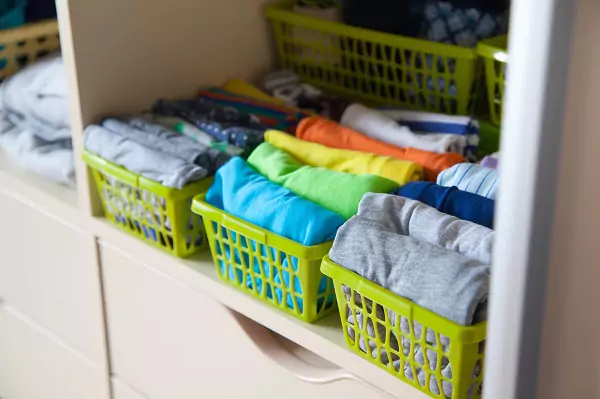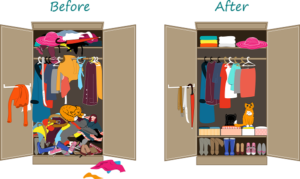How Marie Kondo Can Help You Tidy Up Your Finances
Posted by Century Support Services on May 03, 2019

Marie Kondo has become a household name for her seemingly simple approach to  cleaning up: Keep only the things that “spark joy,” she advises. As it turns out, the same method Kondo proposes for eliminating physical clutter can also be applied to our financial lives.
cleaning up: Keep only the things that “spark joy,” she advises. As it turns out, the same method Kondo proposes for eliminating physical clutter can also be applied to our financial lives.
Here’s a closer look at how Kondo’s six rules of tidying carry over to money management.
1. “Commit yourself to tidying up.”
Kondo says, “The KonMari method does require time and effort. But once you have made up your mind, all you need to do is apply the right method.”
While the tidying guru may be referring to dealing with domestic mess, her words are remarkably applicable to taking control of your finances, whether you are wanting to reduce your spending, plan for the future or get out of credit card debt. Without an attitude of complete commitment, you risk falling back on bad habits. But if you’re ready, willing and able to embrace the process, real and meaningful change is within your reach.
2. “Imagine your ideal lifestyle.”
Have you ever felt compelled to just dive right into the effort of conquering your clutter? According to Kondo, this leads to diminishing returns. Instead, she says, you must first imagine your ideal lifestyle is and how tidying up will help you achieve it. “The tidying up process thus represents a huge turning point,” she insists.
The same holds true when it comes to managing your finances. Some people spend without considering how the spend relates to their overall financial goals. Before you begin the process, spend some time thinking about what your finances would look like in a perfect world. Now, think about how your spending habits can support or hinder this vision.
3. “Tidy by category, not location.”
Most of us have a tendency to clean room by room. Instead, Kondo recommends tidying  according to categories – for example, gathering and inventorying ALL of the clothing before moving on to another category. While this task may seem overwhelming, it’s the only way to get an accurate understanding of just how much stuff you have within each category. Take coats, which are often scattered between closets, coat racks and mudrooms. When you collect all of your coats into one place, however, you can no longer overlook an excess of outerwear. Confronting yourself with the sheer volume of your belongings within a single category also makes it easier to let things go.
according to categories – for example, gathering and inventorying ALL of the clothing before moving on to another category. While this task may seem overwhelming, it’s the only way to get an accurate understanding of just how much stuff you have within each category. Take coats, which are often scattered between closets, coat racks and mudrooms. When you collect all of your coats into one place, however, you can no longer overlook an excess of outerwear. Confronting yourself with the sheer volume of your belongings within a single category also makes it easier to let things go.
This KonMari rule seamlessly translates to financial management. If you don’t have a budget, you need one. But a budget is not enough on its own. You also need thorough budget categories which allow you to drill down to spending specifics. For example, taken on its own, a subscription to Netflix, Hulu, or Prime may not seem like much. However, these fees add up, and grouping them together reveals a clearer picture of their comprehensive impact on your budget.
4. “Follow the right order.”
During the home cleaning process, Kondo recommends working easiest to hardest in terms of keeping/discarding decisions: clothing, followed by books, then papers, next miscellany (“komono”), and finally “sentimental items.” This helps you get used to the process so you’ll be in the right mindset when you get to the more challenging choices.
Applied to your budget, a similar sequence makes sense. The typical household budget includes categories ranging from necessities to nice-to-haves. In order to maximize efficiency, start with assessing how you’re spending money on the former before tackling the latter.
5. “Finish discarding first.”
Do you ever feel like your house is in a constant state of tidying up? If so, it may because you’re sorting without discarding, according to Kondo. We’re all familiar with the adage, “Don’t put off for tomorrow what you can do today.” This goes for your financial practices, in addition to house cleaning. Once you’ve decided to whittle down to one subscription service, cancel the others immediately. Decided to cut back to eating out just once a month? Start now. The more tasks you leave for later, the less likely you are to follow through on them.
6. “Ask yourself if it sparks joy.”
Kondo’s now-famous “Does it ‘spark joy’?” proposition is a straightforward one: If a belonging doesn’t pass this test, it’s time to let it go. “Remember: you are not choosing what to discard, but what to keep,” counsels Kondo. Granted, buying a gallon of milk may never “spark joy,” but many of your other purchases are surprisingly expendable — especially when subjected to this test.
One caveat? While Kondo recommends holding each item in your hands as you sort items in your home,  resist doing so while shopping. Why? Because the mere act of picking something up creates a consumption-driving bond between buyer and product. Instead, revert to point #3: In addition to determining whether it’s a passing fancy or promises true bliss, consider how a particular purchase aligns with your long-term financial goals.
resist doing so while shopping. Why? Because the mere act of picking something up creates a consumption-driving bond between buyer and product. Instead, revert to point #3: In addition to determining whether it’s a passing fancy or promises true bliss, consider how a particular purchase aligns with your long-term financial goals.
Just as tidying up your home can be “life-changing,” so can tidying up your finances. And while it’s no small endeavor, we can think of nothing that “sparks joy” more than smart spending and saving aimed at making your financial dreams a reality.